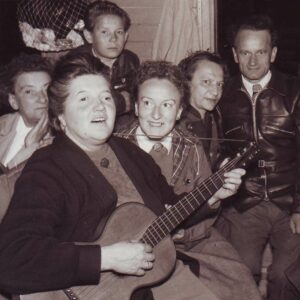Category
ArchiveAbout This Project
J. A. Stauffer / Vienna
The guitar is part of the of the collection Mahn- und Gedenkstaette Ravensbrueck. Ravensbrück concentration camp, built by the SS in 1939, was the largest women’s concentration camp in the German Reich.
The guitar was owned by Cölestine Hübner, an Austrian woman who worked as a singer in Vienna’s wine taverns before her arrest. She was allowed to take along her guitar to the camp, but had to play and sing for the SS during their ‘Viennese Evenings’. She also performed as one half of ‘Tini and Mimi’, a duo she formed with Hermine Freiberger, another Austrian inmate at Ravensbrück.

At some point, the guitar was treated with a modern varnish, probably in order to stabilise or cover the cracks that were already showing back then. Donated to the Memorial in 2011, the guitar went on display in 2013, placed in a climate-controlled vitrine. With the support of Ravensbrück’s International Friends Association (IFK e.V.), which organised a benefit in order to raise funds for this purpose, the guitar’s restoration was begun in 2018.
But first, a plan of action had to be worked out for the restoration effort. The Memorial decided upon a passive conservation strategy. It was the guitar maker and restorer Philipp Neumann (of Leipzig and Antwerp) who was entrusted with the restoration. This included the installation of small blocks to stabilise the cracks in the soundboard, and reglueing the loose sides around the backboard’s bracing. An analysis of the surface treatment showed that the modern coating was an alkyd resin varnish, one that could be stripped from the original shellac without harm. The cleaned surface was then given a coat of beeswax. Originally built by Johann Anton Stauffer in Vienna around 1843–48, this guitar is back on display in Room 4, which is dedicated to ‘Solidarity and Self-Preservation’
more information and quoted from:
https://www.ravensbrueck-sbg.de/en/
download restoration documentation: Dokumentation








